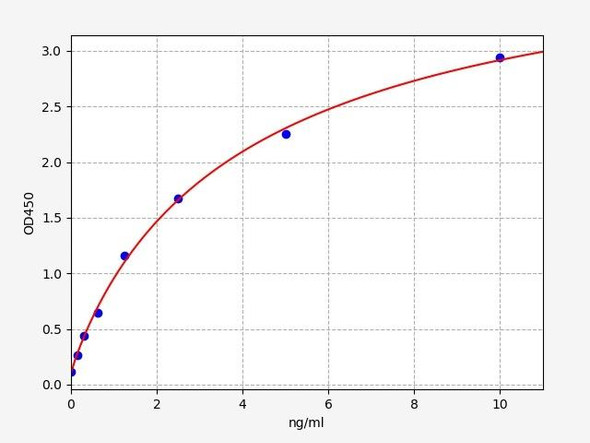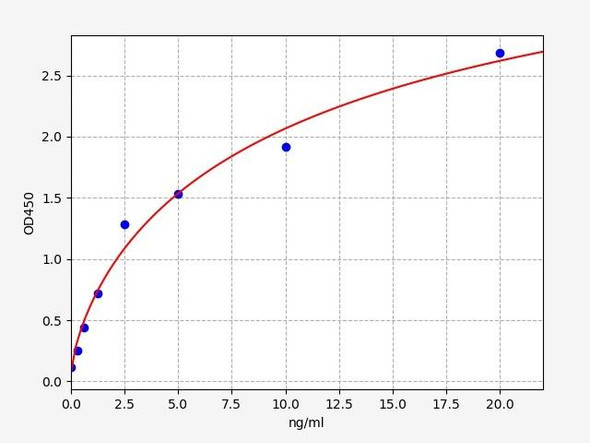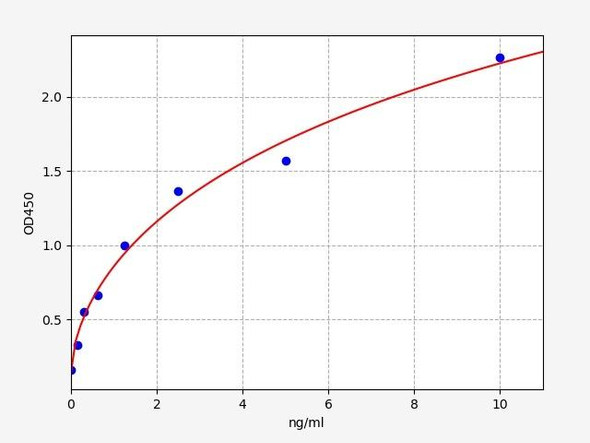Description
Human Neutrophil elastase (ELANE) ELISA Kit
The Human Neutrophil Elastase (ELANE) ELISA Kit is specially designed for the precise measurement of neutrophil elastase levels in human samples such as serum, plasma, and cell culture supernatants. This ELISA kit offers high sensitivity and specificity, ensuring accurate and reproducible results for various research applications.Neutrophil elastase is a key enzyme involved in inflammatory responses, immune function, and tissue remodeling. Dysregulation of neutrophil elastase activity has been linked to various diseases, including chronic obstructive pulmonary disease (COPD), cystic fibrosis, and acute respiratory distress syndrome (ARDS).
By using the Human Neutrophil Elastase ELISA Kit, researchers can gain valuable insights into the role of neutrophil elastase in disease pathogenesis and progression. This kit is an essential tool for studying inflammatory processes, identifying potential therapeutic targets, and developing novel treatment strategies for related disorders.
| Product Name: | Human Neutrophil elastase (ELANE) ELISA Kit |
| SKU: | HUEB0461 |
| Size: | 96T |
| Target: | Human Neutrophil elastase (ELANE) |
| Synonyms: | Bone marrow serine protease, Elastase-2, Human leukocyte elastase, Medullasin, PMN elastase, HLE, ELA2 |
| Assay Type: | Sandwich |
| Detection Method: | ELISA |
| Reactivity: | Human |
| Detection Range: | 78-5000pg/mL |
| Sensitivity: | 31pg/mL |
| Intra CV: | 5.7% | ||||||||||||||||||||
| Inter CV: | 8.1% | ||||||||||||||||||||
| Linearity: |
| ||||||||||||||||||||
| Recovery: |
| ||||||||||||||||||||
| Function: | Modifies the functions of natural killer cells, monocytes and granulocytes. Inhibits C5a-dependent neutrophil enzyme release and chemotaxis. |
| Uniprot: | P08246 |
| Sample Type: | Serum, plasma, tissue homogenates, cell culture supernates and other biological fluids |
| Specificity: | Natural and recombinant human Neutrophil elastase |
| Sub Unit: | Interacts with NOTCH2NL. |
| Storage: | Please see kit components below for exact storage details |
| Note: | For research use only |
| UniProt Protein Function: | ELANE: Modifies the functions of natural killer cells, monocytes and granulocytes. Inhibits C5a-dependent neutrophil enzyme release and chemotaxis. Defects in ELANE are a cause of cyclic haematopoiesis (CH); also known as cyclic neutropenia. CH is an autosomal dominant disease in which blood-cell production from the bone marrow oscillates with 21-day periodicity. Circulating neutrophils vary between almost normal numbers and zero. During intervals of neutropenia, affected individuals are at risk for opportunistic infection. Monocytes, platelets, lymphocytes and reticulocytes also cycle with the same frequency. Defects in ELANE are the cause of neutropenia severe congenital autosomal dominant type 1 (SCN1). SCN1 is a disorder of hematopoiesis characterized by a maturation arrest of granulopoiesis at the level of promyelocytes with peripheral blood absolute neutrophil counts below 0.5 x 10(9)/l and early onset of severe bacterial infections. Belongs to the peptidase S1 family. Elastase subfamily. |
| UniProt Protein Details: | Protein type:Motility/polarity/chemotaxis; Cell cycle regulation; Cell surface; Protease; EC 3.4.21.37 Chromosomal Location of Human Ortholog: 19p13.3 Cellular Component: cell surface; transcriptional repressor complex; cytoplasm; extracellular region; secretory granule Molecular Function:heparin binding; peptidase activity; protein binding; protease binding; cytokine binding; serine-type endopeptidase activity; endopeptidase activity Biological Process: extracellular matrix organization and biogenesis; positive regulation of immune response; positive regulation of smooth muscle cell proliferation; negative regulation of interleukin-8 biosynthetic process; positive regulation of interleukin-8 biosynthetic process; response to lipopolysaccharide; negative regulation of chemotaxis; negative regulation of transcription from RNA polymerase II promoter; proteolysis; phagocytosis; cellular calcium ion homeostasis; positive regulation of MAP kinase activity; extracellular matrix disassembly; collagen catabolic process; negative regulation of inflammatory response; defense response to bacterium; protein catabolic process; response to yeast; leukocyte migration; acute inflammatory response to antigenic stimulus; response to UV; negative regulation of chemokine biosynthetic process Disease: Cyclic Neutropenia; Neutropenia, Severe Congenital, 1, Autosomal Dominant |
| NCBI Summary: | Elastases form a subfamily of serine proteases that hydrolyze many proteins in addition to elastin. Humans have six elastase genes which encode the structurally similar proteins. The product of this gene hydrolyzes proteins within specialized neutrophil lysosomes, called azurophil granules, as well as proteins of the extracellular matrix following the protein's release from activated neutrophils. The enzyme may play a role in degenerative and inflammatory diseases by its proteolysis of collagen-IV and elastin of the extracellular matrix. This protein degrades the outer membrane protein A (OmpA) of E. coli as well as the virulence factors of such bacteria as Shigella, Salmonella and Yersinia. Mutations in this gene are associated with cyclic neutropenia and severe congenital neutropenia (SCN). This gene is clustered with other serine protease gene family members, azurocidin 1 and proteinase 3 genes, at chromosome 19pter. All 3 genes are expressed coordinately and their protein products are packaged together into azurophil granules during neutrophil differentiation. [provided by RefSeq, May 2009] |
| UniProt Code: | P08246 |
| NCBI GenInfo Identifier: | 119292 |
| NCBI Gene ID: | 1991 |
| NCBI Accession: | P08246.1 |
| UniProt Secondary Accession: | P08246,P09649, Q6B0D9, Q6LDP5, |
| UniProt Related Accession: | P08246 |
| Molecular Weight: | 28,518 Da |
| NCBI Full Name: | Neutrophil elastase |
| NCBI Synonym Full Names: | elastase, neutrophil expressed |
| NCBI Official Symbol: | ELANE |
| NCBI Official Synonym Symbols: | GE; NE; HLE; HNE; ELA2; SCN1; PMN-E |
| NCBI Protein Information: | neutrophil elastase; elastase-2; medullasin; PMN elastase; leukocyte elastase; elastase 2, neutrophil; human leukocyte elastase; polymorphonuclear elastase; bone marrow serine protease; granulocyte-derived elastase |
| UniProt Protein Name: | Neutrophil elastase |
| UniProt Synonym Protein Names: | Bone marrow serine protease; Elastase-2; Human leukocyte elastase; HLE; Medullasin; PMN elastase |
| Protein Family: | Elastase |
| UniProt Gene Name: | ELANE |
| UniProt Entry Name: | ELNE_HUMAN |
| Component | Quantity (96 Assays) | Storage |
| ELISA Microplate (Dismountable) | 8×12 strips | -20°C |
| Lyophilized Standard | 2 | -20°C |
| Sample Diluent | 20ml | -20°C |
| Assay Diluent A | 10mL | -20°C |
| Assay Diluent B | 10mL | -20°C |
| Detection Reagent A | 120µL | -20°C |
| Detection Reagent B | 120µL | -20°C |
| Wash Buffer | 30mL | 4°C |
| Substrate | 10mL | 4°C |
| Stop Solution | 10mL | 4°C |
| Plate Sealer | 5 | - |
Other materials and equipment required:
- Microplate reader with 450 nm wavelength filter
- Multichannel Pipette, Pipette, microcentrifuge tubes and disposable pipette tips
- Incubator
- Deionized or distilled water
- Absorbent paper
- Buffer resevoir
*Note: The below protocol is a sample protocol. Protocols are specific to each batch/lot. For the correct instructions please follow the protocol included in your kit.
Allow all reagents to reach room temperature (Please do not dissolve the reagents at 37°C directly). All the reagents should be mixed thoroughly by gently swirling before pipetting. Avoid foaming. Keep appropriate numbers of strips for 1 experiment and remove extra strips from microtiter plate. Removed strips should be resealed and stored at -20°C until the kits expiry date. Prepare all reagents, working standards and samples as directed in the previous sections. Please predict the concentration before assaying. If values for these are not within the range of the standard curve, users must determine the optimal sample dilutions for their experiments. We recommend running all samples in duplicate.
| Step | |
| 1. | Add Sample: Add 100µL of Standard, Blank, or Sample per well. The blank well is added with Sample diluent. Solutions are added to the bottom of micro ELISA plate well, avoid inside wall touching and foaming as possible. Mix it gently. Cover the plate with sealer we provided. Incubate for 120 minutes at 37°C. |
| 2. | Remove the liquid from each well, don't wash. Add 100µL of Detection Reagent A working solution to each well. Cover with the Plate sealer. Gently tap the plate to ensure thorough mixing. Incubate for 1 hour at 37°C. Note: if Detection Reagent A appears cloudy warm to room temperature until solution is uniform. |
| 3. | Aspirate each well and wash, repeating the process three times. Wash by filling each well with Wash Buffer (approximately 400µL) (a squirt bottle, multi-channel pipette,manifold dispenser or automated washer are needed). Complete removal of liquid at each step is essential. After the last wash, completely remove remaining Wash Buffer by aspirating or decanting. Invert the plate and pat it against thick clean absorbent paper. |
| 4. | Add 100µL of Detection Reagent B working solution to each well. Cover with the Plate sealer. Incubate for 60 minutes at 37°C. |
| 5. | Repeat the wash process for five times as conducted in step 3. |
| 6. | Add 90µL of Substrate Solution to each well. Cover with a new Plate sealer and incubate for 10-20 minutes at 37°C. Protect the plate from light. The reaction time can be shortened or extended according to the actual color change, but this should not exceed more than 30 minutes. When apparent gradient appears in standard wells, user should terminatethe reaction. |
| 7. | Add 50µL of Stop Solution to each well. If color change does not appear uniform, gently tap the plate to ensure thorough mixing. |
| 8. | Determine the optical density (OD value) of each well at once, using a micro-plate reader set to 450 nm. User should open the micro-plate reader in advance, preheat the instrument, and set the testing parameters. |
| 9. | After experiment, store all reagents according to the specified storage temperature respectively until their expiry. |
When carrying out an ELISA assay it is important to prepare your samples in order to achieve the best possible results. Below we have a list of procedures for the preparation of samples for different sample types.
| Sample Type | Protocol |
| Serum | If using serum separator tubes, allow samples to clot for 30 minutes at room temperature. Centrifuge for 10 minutes at 1,000x g. Collect the serum fraction and assay promptly or aliquot and store the samples at -80°C. Avoid multiple freeze-thaw cycles. If serum separator tubes are not being used, allow samples to clot overnight at 2-8°C. Centrifuge for 10 minutes at 1,000x g. Remove serum and assay promptly or aliquot and store the samples at -80°C. Avoid multiple freeze-thaw cycles. |
| Plasma | Collect plasma using EDTA or heparin as an anticoagulant. Centrifuge samples at 4°C for 15 mins at 1000 × g within 30 mins of collection. Collect the plasma fraction and assay promptly or aliquot and store the samples at -80°C. Avoid multiple freeze-thaw cycles. Note: Over haemolysed samples are not suitable for use with this kit. |
| Urine & Cerebrospinal Fluid | Collect the urine (mid-stream) in a sterile container, centrifuge for 20 mins at 2000-3000 rpm. Remove supernatant and assay immediately. If any precipitation is detected, repeat the centrifugation step. A similar protocol can be used for cerebrospinal fluid. |
| Cell culture supernatant | Collect the cell culture media by pipette, followed by centrifugation at 4°C for 20 mins at 1500 rpm. Collect the clear supernatant and assay immediately. |
| Cell lysates | Solubilize cells in lysis buffer and allow to sit on ice for 30 minutes. Centrifuge tubes at 14,000 x g for 5 minutes to remove insoluble material. Aliquot the supernatant into a new tube and discard the remaining whole cell extract. Quantify total protein concentration using a total protein assay. Assay immediately or aliquot and store at ≤ -20 °C. |
| Tissue homogenates | The preparation of tissue homogenates will vary depending upon tissue type. Rinse tissue with 1X PBS to remove excess blood & homogenize in 20ml of 1X PBS (including protease inhibitors) and store overnight at ≤ -20°C. Two freeze-thaw cycles are required to break the cell membranes. To further disrupt the cell membranes you can sonicate the samples. Centrifuge homogenates for 5 mins at 5000xg. Remove the supernatant and assay immediately or aliquot and store at -20°C or -80°C. |
| Tissue lysates | Rinse tissue with PBS, cut into 1-2 mm pieces, and homogenize with a tissue homogenizer in PBS. Add an equal volume of RIPA buffer containing protease inhibitors and lyse tissues at room temperature for 30 minutes with gentle agitation. Centrifuge to remove debris. Quantify total protein concentration using a total protein assay. Assay immediately or aliquot and store at ≤ -20 °C. |
| Breast Milk | Collect milk samples and centrifuge at 10,000 x g for 60 min at 4°C. Aliquot the supernatant and assay. For long term use, store samples at -80°C. Minimize freeze/thaw cycles. |










